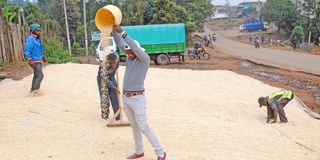Brief news on farming and agribusiness in the country

Youth winnow maize along a road in Elburgon, Nakuru County. According to the Kenya Bureau of Standards, most of the maize sold in the country contains unacceptable levels of aflatoxin, making it unfit for human consumption. PHOTO | FILE | NATION MEDIA GROUP
What you need to know:
- To fully safeguard consumers against aflatoxin, we need to ensure that controlled measures are put in place from the source as the issue is usually caused by either contaminated maize fields or poor practices during storage
- Kenya is among countries with high aflatoxin challenges. According to the Kenya Bureau of Standards, most of the maize sold in the country contains unacceptable levels of the toxin, making it unfit for human consumption.
- Dam liners are made from geomembrane, which is a synthetic polymer material of very low permeability used to hold water. In Kenya, they are available as high density polyethylene (HDPE) or low density polyethylene (LDPE).
- When choosing the right fish pond liner to use, ensure that the material is chemically treated against rapid UV (Ultra violet rays) degradation.
Subsidise cost of aflatoxin chemicals, miller asks State
The government has been asked to subsidise the cost of chemicals used in curbing aflatoxin to safeguard grains during the Covid-19 pandemic period.
Rajan Shah, the chief executive of Capwell Industries, which processes maize and other grains, said subsidising Aflasafe, a natural solution to aflatoxin would make it affordable for every farmer to apply it on their crops to control the menace.
“To fully safeguard consumers against aflatoxin, we need to ensure that controlled measures are put in place from the source as the issue is usually caused by either contaminated maize fields or poor practices during storage,” Shah said.
The Kenya Agricultural and Livestock Research Organisation is among agencies manufacturing the product in the country.
Shah said access to the product would even it easier for millers to buy the produce from farmers, knowing that it is safe.
Kenya is among countries with high aflatoxin challenges. According to the Kenya Bureau of Standards, most of the maize sold in the country contains unacceptable levels of the toxin, making it unfit for human consumption.
Shah further called on the government to be guided by data on food deficit before importing maize and ensuring that the reserves are not fully depleted before making the decision.
As the country battles Covid-19, he said farmers are among the worst affected by the negative effects of the disease.
“As a firm, we have expedited payment cycle that allows us to pay farmers on time to help them sustain an improved cash cycle during this pandemic. Our pricing is based on the forces of demand and supply while keeping in mind the benefits farmers look to get after selling their produce,” said Shah of the firm that specialises in the production of quality maize flour, rice, pulses and porridges.
The firm sources its grains from some 3,000 farmers in Trans Nzoia, Nakuru, Laikipia, Uasin Gishu, and Bomet counties. It also imports the grains from Tanzania (Arusha) and Uganda to maintain its production capacity of 360 metric tonnes per day.
-By Brian Okinda
****
Choosing best liner for a pond or dam
Dam liners are made from geomembrane, which is a synthetic polymer material of very low permeability used to hold water. In Kenya, they are available as high density polyethylene (HDPE) or low density polyethylene (LDPE).
With the rapid growth of fish farms across the country, and development of water reservoirs for irrigation, fish pond liners use has grown exponentially. Farmers have to choose not just between the various types but also the right thickness .
The most common dam liner thicknesses in Kenya are 0.5mm/500 microns, 0.75mm/750 microns and 1mm/1,000 microns. The appropriate thickness is determined by the volume of water to be held and the surface texture.
For instance, a farmer conserving 20,000 cubic or 20 million litres of water will use a thicker gauge than one conserving 1,000 cubic or 1 million litres of water. Again, a farmer whose water reservoir’s surface is stony or rocky will use a thicker gauge than one whose reservoir’s surface is all soil or cemented.
When choosing the right fish pond liner to use, ensure that the material is chemically treated against rapid UV (Ultra violet rays) degradation.
This means that your liner will have a longer usable lifespan under the sun. UV treatment is key in Kenya which lies on the equator where UV radiation strong.
Geomembranes come in large rolls with widths of between 7M and 8M.
Therefore, it is welded together under high heat to achieve wider reservoir dimensions. This must be conducted by a trained technician to avoid damage and leakage to the material.
Dam liners have a lifespan of several years in the open field, which could be as high as 35 years and as low as eight depending on the thickness, UV treatment and personal care during use.
-By Wamae Mwangi
Mwangi is the director at Grekkon Limited- Irrigation Hub.





